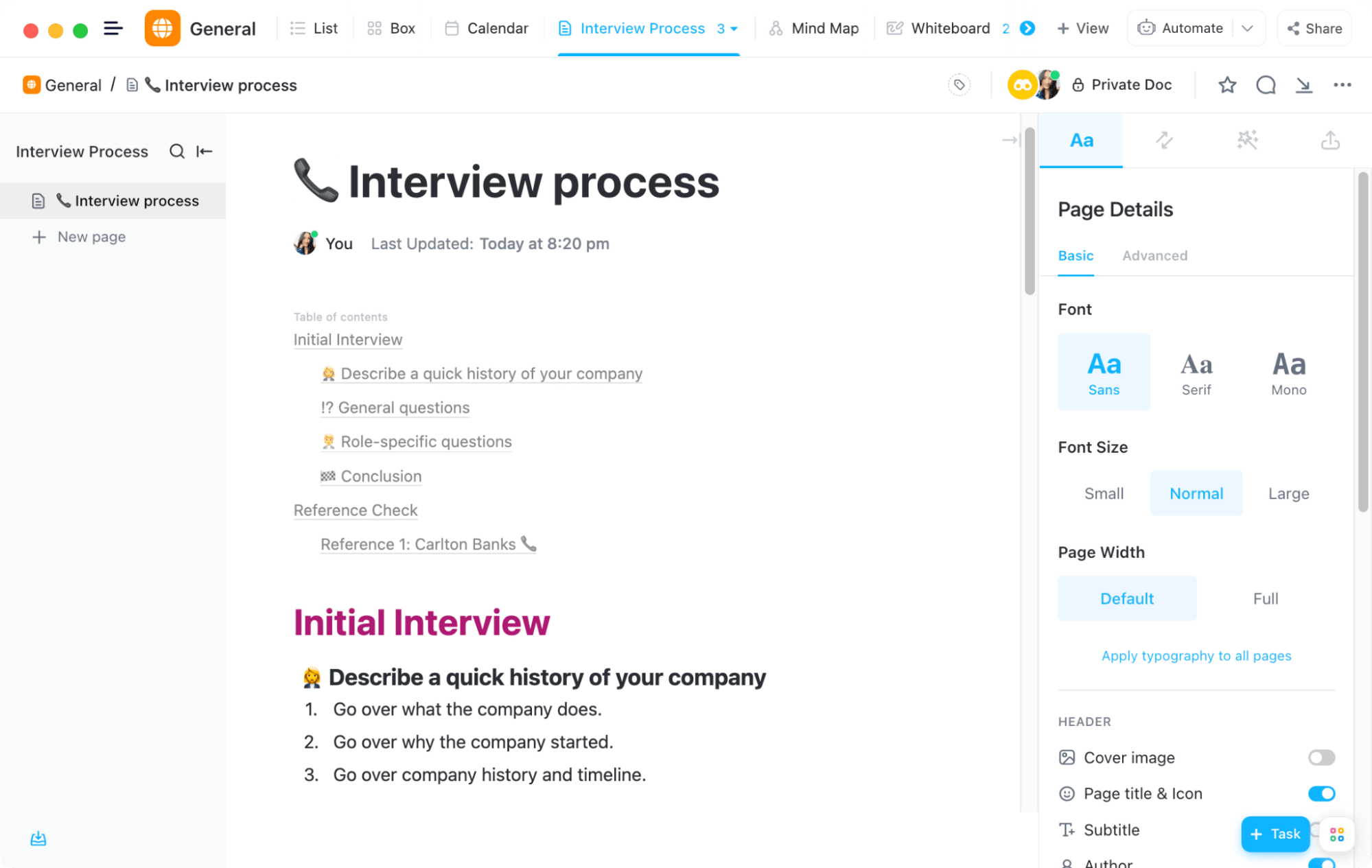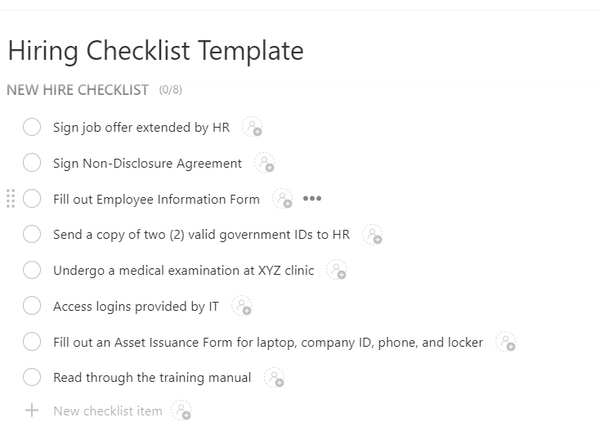يتوقف نجاح أي مؤسسة مدعومة بالتكنولوجيا اليوم على وجود فريق موهوب وقادر على هندسة البرمجيات. ومع ذلك، فإن تجميع فريق عمل متميز ينطوي على نهج استراتيجي لتوظيف مطوري البرمجيات. أنت بحاجة إلى التركيز على المواهب أثناء انتقاء الأدوار المتخصصة. وفي الوقت نفسه، تحتاج في الوقت نفسه إلى وضع هدف تطوير البرمجيات الأكبر في الاعتبار.
لتطوير برمجيات عالية الجودة، يجب أن تبني فريقاً يتمتع بمهارات تقنية تكميلية مع التركيز على المهارات الشخصية والشخصية.
هذا الدليل حول كيفية توظيف مهندس برمجيات يمكن أن يقربك خطوة واحدة من هذا الهدف.
لماذا توظف مهندس برمجيات؟
لنبدأ بالأساسيات - لماذا تحتاج إلى مهندس برمجيات؟
على الرغم من أن هذا يعتمد على طبيعة شركتك ومشاريعك، إليك نظرة عامة عالية المستوى لما يقدمه مهندسو البرمجيات:
- الخبرة التقنية: مهندسو البرمجيات هم مهندسو برمجيات محترفون مهرة يتمتعون بفهم عميق للغات البرمجة ومنهجيات تطوير البرمجيات والأطر الرقمية وأحدث التقنيات. وتؤدي هذه المعرفة دورًا أساسيًا في بناء النظام البيئي الرقمي للمؤسسة وصيانته وتعزيزه
- الابتكار: غالبًا ما يكون مطورو البرمجيات هم العقل المدبر وراء الابتكار والتقدم التكنولوجي. وسواء أكانوا يبنون حلاً من الصفر أو يحسّنون حلاً قائماً، فإنهم يساعدون الشركات على الحفاظ على قدرتها التنافسية من خلال ترقية أدواتها وتقنياتها
- عقلية حل المشاكل: إن مهاراتهم التقنية والتحليلية تجعل مهندسي البرمجيات حلالي المشاكل بالفطرة. كما أن نهجهم المنطقي والمنهجي والمنظم بالفطرة يجعلهم رصيدًا لا يقدر بثمن في حل المشكلات التقنية لزيادة الإنتاجية والكفاءة
- تطوير المنتجات: سواء كنت تعمل في مجال تطوير منتجات البرمجيات للعملاء أو ترغب في إنشاء حل مخصص لاحتياجات عمل محددة، ستحتاج إلى مطور برمجيات. فهم يلعبون دورًا حاسمًا خلال دورة التطوير، بدءًا من التصميم الأولي إلى التطوير والاختبار والنشر والصيانة
القائمة أعلاه إرشادية وليست موسعة بأي حال من الأحوال، حيث يمكن أن تتغير المخرجات اعتمادًا على الأهداف المحددة لمهندسي البرمجيات .
## علامات تحتاج إلى توظيف مهندس برمجيات
من المؤكد أن مطوري البرمجيات لديهم الكثير ليقدموه. ولكن كيف تتوافق خبراتهم مع الأهداف التنظيمية الشاملة؟ كيف تعرف متى تحتاج إلى توظيف مهندس برمجيات؟
لمساعدتك في الإجابة على هذه الأسئلة، قمنا بتجميع العلامات التي تشير إلى أن الوقت قد حان لتوظيف مطور برمجيات:
- فريق العمل الحالي مثقل بالعمل باستمرار وتظهر عليه علامات الإرهاق
- تأخيرات في الجداول الزمنية للمشروع بسبب مشاكل مثل عدم توفر الموارد أو قيود أخرى
- وجود أخطاء متكررة أو أخطاء أو مشكلات في الأداء تشير إلى وجود فجوة في المهارات
- حلول برمجية غير مرنة غير قادرة على التوسع حسب متطلبات العمل
- استخدام أنظمة قديمة أو تقنيات قديمة تعيق الأداء أو الأمان
- تحمل الفرق غير التقنية لعبء العمل في القضايا المتعلقة بالتكنولوجيا
- ارتفاع معدلات دوران الموظفين في فريق التطوير تليها عملية توظيف مطولة
- الافتقار إلى الابتكار الذي يعرض الأعمال للخطر من حيث المنتج أو الميزات أو الأداء
يجب أن تؤدي الأعراض المذكورة أعلاه إلى تنشيط عملية البحث عن مواهب تطوير البرمجيات، سواءً كانت فردية أو جماعية، لمعالجة هذه التحديات قبل أن تتفاقم.
المهارات والمؤهلات الشائعة التي يجب البحث عنها في مهندس البرمجيات
بمجرد أن تتعرف على الحاجة إلى توظيف مهندسي برمجيات، حدد الفجوات في المهارات أو أي متطلبات أخرى. سيوفر هذا التحليل رؤية واضحة للمهارات والمؤهلات التي يمكن إضافتها إلى الوصف الوظيفي أثناء عملية طلب التوظيف.
لإعطائك فكرة عن المعايير المختلفة المطلوبة، استخدم القائمة التالية من مهارات ومؤهلات هندسة البرمجيات الشائعة كمرجع:
المهارات التقنية
قد تختلف المهارات التقنية لمطور البرمجيات حسب بيئة التطوير. ولكنك ستبحث عادةً عن
- لغات البرمجة: الكفاءة التقنية في واحدة أو أكثر من لغات البرمجة، مثل Java وJava وJava JavaScript وC++ وPython وScala وغيرها. يجب أن تتماشى مع لغات البرمجة المستخدمة فيالمكدس التقني
- التصميم الموجه للكائنات (OOD): فهم مفاهيم OOD مثل التغليف، والتجريد، والتوريث، والتعميم، والتحلل
- تطوير الويب: المعرفة بتقنيات وأطر ومكتبات تطوير الويب الأمامية أو الخلفية أو تطوير الويب الكامل
- إدارة قواعد البيانات وإدارتها: الإلمام بأنظمة إدارة قواعد البيانات مثل MongoDB و PostgreSQL و MySQL وغيرها.
- التحكم في الإصدارات: خبرة في العمل مع أنظمة التحكم في الإصدار مثل Git للبرمجة التعاونية
- منهجيات تطوير البرمجيات: فهم لمنهجيات Agile أو Scrum أو DevOps أو أي منهجيات أخرى لتطوير البرمجيات
- الاختبار وتصحيح الأخطاء: القدرة على كتابة اختبارات الوحدات، واختبار التطبيقات، وإجراء مراجعات التعليمات البرمجية، وتصحيح الأخطاء
- الحوسبة السحابية: معرفة عملية بالمنصات السحابية مثل Google Cloud وAWS وAzure
- تطوير الأجهزة المحمولة: القدرة على تطوير تطبيقات الأجهزة المحمولة لأنظمة تشغيل مختلفة مثل iOS أو Android باستخدام Swift وKotlin أو Java، على التوالي
لا تتردد في اختيار المهارات التقنية وأدوات تطوير البرمجيات التي تتناسب مع متطلبات المشروع.
على سبيل المثال، سيتطلب تطوير تطبيقات للأجهزة المحمولة إتقان لغات البرمجة مثل Swift أو Kotlin أو Java، مقترنة بمعرفة أطر عمل تطوير الأجهزة المحمولة مثل React Native أو Flutter أو Xamarin.
في المقابل، فإن المهارات التقنية اللازمة لتخصيص منصة إدارة علاقات العملاء المستندة إلى السحابة تتضمن الإلمام بالبيئة السحابية، وتخصيص واجهة برمجة التطبيقات، ولغات البرمجة النصية، والتكاملات وخطافات الويب، وغير ذلك.
المهارات الأساسية
نادراً ما يعمل مهندسو البرمجيات في فراغ. وبالنظر إلى أنهم قد يعملون مع فريق أو يتفاعلون مع أصحاب المصلحة الداخليين أو الخارجيين، فإنك تتوقع منهم امتلاك المهارات الشخصية والشخصية التالية:
- حل المشاكل: عقلية تحليلية إلى جانب التفكير الإبداعي لحل المشاكل المعقدة
- الاهتمام بالتفاصيل: الدقة في ممارسات التوثيق والترميز والاختبار لضمان جودة المنتج
- التواصل: التواصل: مهارات التواصل والتعاون لفهم مواصفات مشروع البرنامج وتوضيحها، والعمل مع أعضاء الفريق، وإشراك أصحاب المصلحة
- روح الفريق: القدرة على الاندماج بشكل متماسك في إعداد الفريق والتعاون مع الآخرين للمساهمة في تحقيق الأهداف المشتركة
- إدارة الوقت: إدارة الوقت: إدارة الوقت بفعالية للوفاء بمعالم المشروع والمواعيد النهائية وفقًا لجدول زمني محدد
- الرغبة في التعلم: القدرة على تكييف الاستراتيجيات وتحويلها أو دمج التقنيات الحديثة، مثل استخدامأدوات الذكاء الاصطناعي للمطورين لتحسين جودة البرمجيات
المؤهلات
هنا حيث ستبحث عن مؤهلات محددة مثل:
- التعليم: يفضل الحصول على شهادة عليا أو بكالوريوس في علوم الحاسب الآلي أو هندسة البرمجيات أو مجال ذي صلة، وإن لم يكن إلزاميًا
- الشهادة: تطوير البرمجيات ذات الصلة وشهادات البرمجة مثل مهندس ديف أوبس معتمد من AWS، أو مطور تطبيقات Kubernetes المعتمد (CKAD)، وما إلى ذلك لإثبات الخبرة المتخصصة
- خبرة العمل: محفظة لعرض الخبرة السابقة في العمل على مشاريع متعددة، وتحديدًا المشاريع المشابهة للمتطلبات الحالية
- المشاركة المجتمعية: المشاركة في المنتديات عبر الإنترنت لمهندسي البرمجيات أو ورش عمل التطوير المهني والفعاليات والمؤتمرات
من خلال التخطيط بعناية للمهارات التقنية والمهارات الشخصية والمؤهلات الموضحة أعلاه، يمكنك تطوير ملف تعريف شامل أو وصف وظيفي لمهندس برمجيات مثالي يتوافق مع متطلبات العمل.
تذكر أن هذا القالب هو مجرد نقطة بداية - قم بتخصيصه وفقًا لمتطلبات مشروعك الفريدة، والمجموعة التقنية، ومعايير الصناعة، وأهداف الشركة، وعالم التكنولوجيا المتغير باستمرار.
كيفية توظيف مهندس برمجيات: دليل شامل من 14 خطوة
الآن وبعد أن وضعت الأساس لتوظيف مهندسي البرمجيات، حان الوقت للغوص في العملية. فيما يلي دليل مفصل خطوة بخطوة حول كيفية توظيف مهندسي البرمجيات.
الخطوة 1: تحديد احتياجات مشروع تطوير البرمجيات
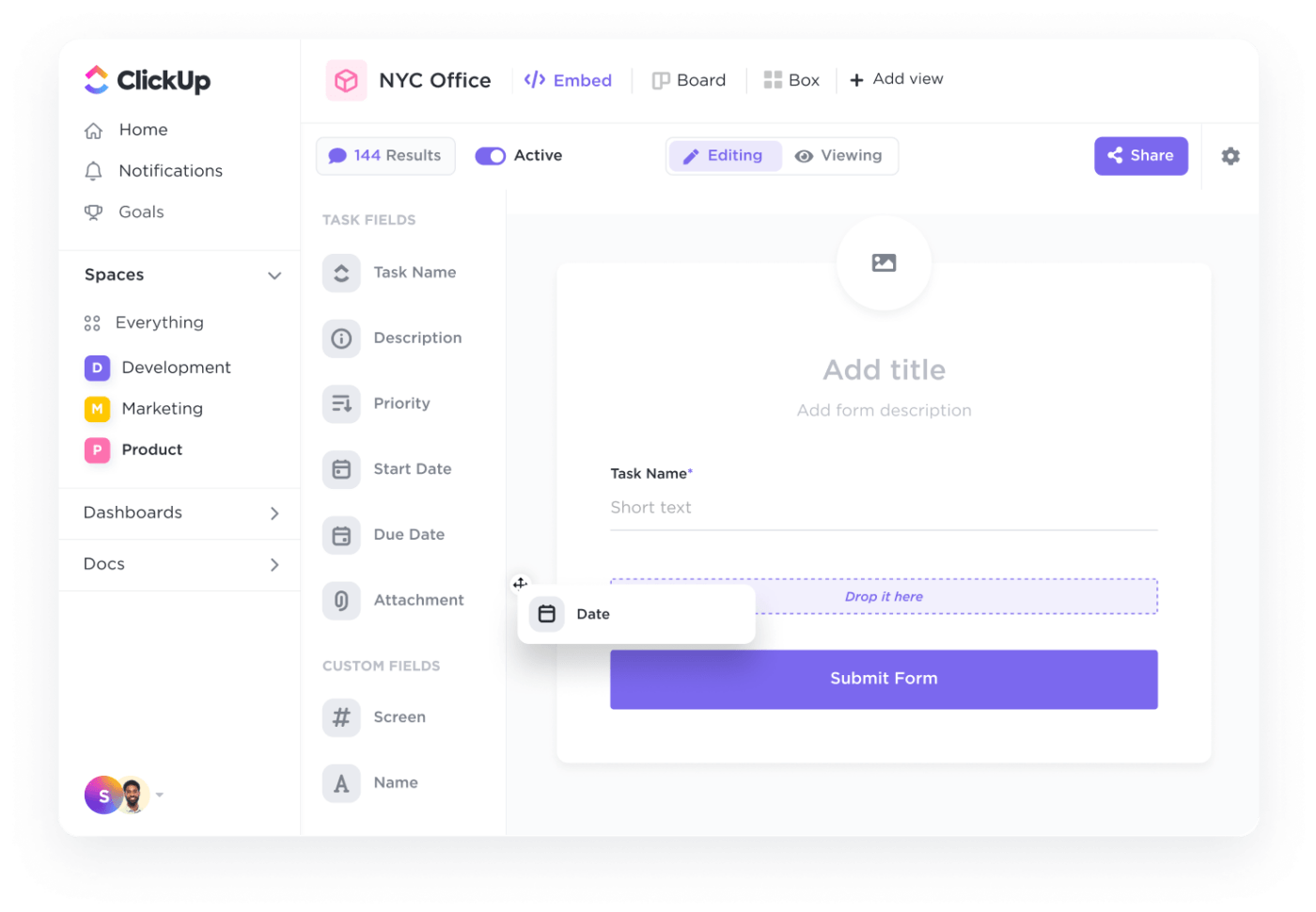
استخدام النماذج لالتقاط طلبات طلب المواهب باستخدام ClickUp
تقييم متطلبات مشروع تطوير البرمجيات هو الخطوة الأولى والحاسمة في عملية التوظيف. وسيتضمن تقييم متطلبات المشروع وفقًا لمعايير مثل:
- النطاق
- الأهداف
- المتطلبات الفنية
- المنجزات
احرص على أن توضح هذه العناصر تعقيدات المشروع والمخاطر أو التحديات مع تحديد النتائج المرجوة والمعايير المقابلة لها.
بعد ذلك، قم بإشراك مدير المشروع وأعضاء الفريق الحاليين لتحديد:
- مجموعات المهارات المطلوبة
- أدوات أو منهجيات تطوير البرمجيات الحالية
- تكنولوجيا المهام الحرجة
قارن بين تكوين فريقك الحالي وقدراته من أجل تحديد أي ثغرات في المهارات التي يمكن أن يعالجها الموظف الجديد.
في بعض الحالات، قد تكتشف متطلبات مستقبلية أو بديلاً أكثر تأهيلاً لتوسيع القدرات. على سبيل المثال، قد يكون توظيف مهندس برمجيات متكامل أكثر فائدة، حتى لو كانت متطلبات المشروع الحالي تدور حول تطوير الواجهة الخلفية. إن الحفاظ على المرونة لدمج مثل هذه الأهداف طويلة الأجل يستخلص قيمة أكبر من التوظيف الحالي بدلاً من إعادة الدورة بأكملها.
يسمح مثل هذا التقييم الشامل لاحتياجات مشروع تطوير البرمجيات لمديري التوظيف بتحديد المرشحين الذين يلبون المتطلبات الفورية وكذلك المتطلبات طويلة الأجل.
الخطوة 2: صياغة وصف وظيفي شامل
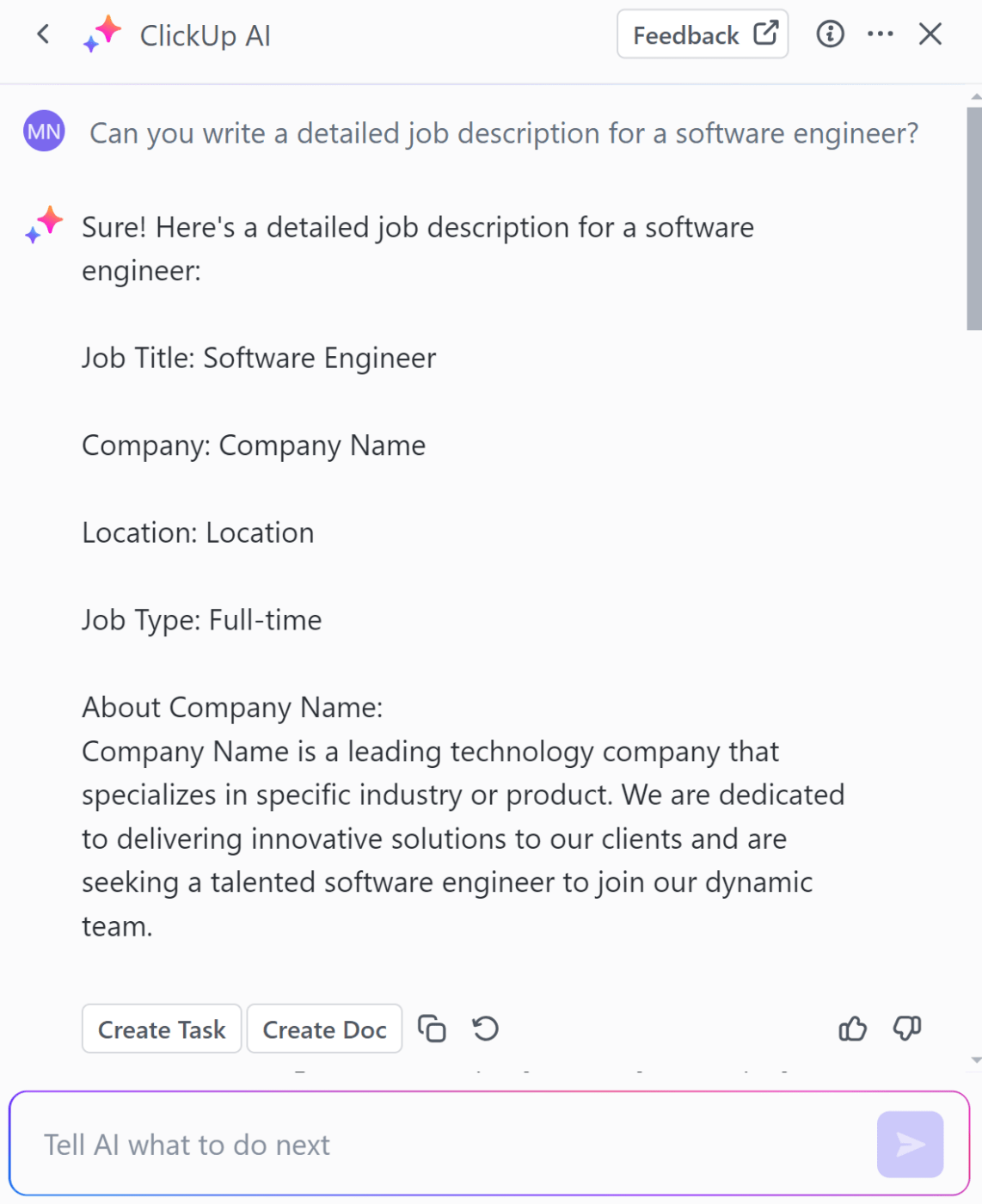
صياغة دفاتر يومية مقنعة ومفصلة باستخدام ClickUp Brain
بعد ذلك، ترجم الفجوات في المهارات ومتطلبات المشروع إلى وصف وظيفي مفصل.
عادةً ما يتضمن الوصف الوظيفي المصاغ بشكل جيد ما يلي:
- نظرة عامة عن الشركة: بعض المعلومات الأساسية عن رسالة الشركة ورؤيتها وبياناتها القيمية
- نبذة عن مهندس البرمجيات: قائمة بالأدوار والمسؤوليات والتوقعات والالتزامات التي تحدد الأدوار والمسؤوليات والالتزاماتما يتوقع أن يقوم به مطور البرمجيات على أساس يومي
- المؤهلات التقنية: المهارات التقنية، ولغات البرمجة، وبيئة التطوير، والأدوات والتقنيات، ومنهجيات تطوير البرمجيات، والمؤهلات التعليمية، والشهادات، وما إلى ذلك، التي تتماشى مع احتياجات مشروع تطوير البرمجيات
- المؤهلات غير التقنية: المهارات الشخصية مثل التواصل، والتعاون، ومهارات حل المشكلات، وإدارة الوقت، والقدرة على التكيف، وما إلى ذلك، لضمان ملاءمة المطور لثقافة العمل
- المميزات الرئيسية: الأسباب التي تدفع المرشح للتقدم لوظيفة مطور البرامج هذه. على سبيل المثال، يمكنك تسليط الضوء على الجوانب الفريدة للوظيفة (العمل عن بُعد، وساعات العمل المرنة، وخلوات الشركة، وما إلى ذلك)، وشهادات مكان العمل، وغيرها من التفاصيل التي قد تجذب أفضل المواهب
- الأجر: قم بالإعلان عن الأجر في البداية لتمكين المتقدمين من إدارة توقعات رواتبهم. شارك تفصيلاً شاملاً للأجر والبدلات الأخرى مثل المكافآت المرتبطة بالأداء، والتأمين الصحي، ومزايا ESOPs، ومزايا التقاعد، وما إلى ذلك. حتى إذا كنت غير قادر على الإفصاح عن مبلغ ثابت، شارك تقديرًا تقريبيًا
سيكون هذا الوصف الوظيفي هو مخططك أثناء البحث عن المواهب!
💡 نصيحة احترافية: استخدم ClickUp Brain's الذكاء الاصطناعي لصياغة توصيفات وظيفية بسرعة يمكنك تعديلها حسب رغبتك_
الخطوة 3: تحقق من احتياطي المواهب لديك
يمكنك أيضًا إجراء مراجعة شاملة لاحتياطيات المواهب الموجودة لديك قبل إدراج الوصف الوظيفي والبدء في عملية التوظيف.
تتضمن هذه المرحلة:
- مراجعة ملفات المرشحين المدرجين في القائمة المختصرة من دورات التوظيف السابقة,
- استكشاف المرشحين الداخليين المؤهلين للترقية و
- الاستفادة من قواعد البيانات الداخلية لاستكشاف فرص تنقل أو تطوير المواهب الداخلية
وبالاستفادة من هذه الاحتياطيات، يمكن للمؤسسات تخفيض تكاليف التوظيف والجداول الزمنية
على سبيل المثال، من خلال تقييم الطلبات السابقة، ستجد المرشحين الذين أعربوا بالفعل عن رغبتهم في العمل معك والذين سبق أن فحصت ملفاتهم الشخصية.
ومن ناحية أخرى، يتمتع المرشحون الداخليون بالخبرة والملاءمة الثقافية ولن يحتاجوا إلا إلى التدريب وصقل المهارات للتقدم من دورهم الحالي لتولي مسؤولية مطور برمجيات. كما أن تنمية الأشخاص من الداخل يخلق ثقافة الاعتراف بالقدرات والنمو الوظيفي المحتمل، مما سيؤدي إلى رعاية المواهب والاحتفاظ بها وجذبها.
الخطوة 4: النشر على بوابات الوظائف عبر الإنترنت
يأتي الآن الجزء الذي تقوم فيه بنشر الوصف الوظيفي على بوابات الوظائف المختلفة، وتحديداً البوابات الإلكترونية، حيث إنها تفتح إمكانية توظيف مهندسي البرمجيات عن بُعد.
ابدأ بوضع قائمة مختصرة بالمنصات الإلكترونية ذات الصلة مثل LinkedIn وEld وGlassdoor وغيرها. يمكنك أيضًا استكشاف لوحات الوظائف التقنية المتخصصة حيث يبحث كبار مطوري البرمجيات عن فرص عمل.
تحقق من الوظائف الأخرى المدرجة على هذه المنصات وقم بضبط وظيفتك لتبرز. قم بتسليط الضوء على الامتيازات والبدلات وأي ميزات بارزة مرتبطة بالوظيفة، مثل فرص العمل عن بُعد، والتوازن بين العمل والحياة، ونزهات الشركة، وما إلى ذلك. قم أيضًا بتضمين كلمات رئيسية خاصة بالمجال وتحسين الوصف الوظيفي لزيادة الظهور.
شارك القائمة على منصات التواصل الاجتماعي والمجموعات الأخرى لتوسيع نطاق انتشارها.
الخطوة 5: تفاعل مع مجتمع التكنولوجيا
قد تجد أفضل مطوري البرمجيات يتسكعون في المنتديات عبر الإنترنت، ومؤتمرات الصناعة، واللقاءات المحلية. سيساعدك جعل وجودك محسوسًا هنا في بحثك. يمكنك أيضًا استخدام ذلك كفرصة لعرض مؤسستك كمكان رائع للعمل.
وفي الوقت نفسه، فإن الانخراط مع المجتمع سيطلعك على أحدث الاتجاهات في عالم التكنولوجيا، مثل مجموعة المهارات التي يزداد الطلب عليها وتلك التي يتراجع الطلب عليها، مع إعطائك فكرة عن سوق العمل.
يمكن للمشاركة في المجتمع ومشاركة الرؤى وبناء العلاقات أن يوصلك بمطوّري البرمجيات المتميزين الذين قد لا يبحثون بنشاط عن وظائف ولكنهم يمتلكون المهارات والخبرات التي تبحث عنها.
هذه المرحلة اختيارية، ولكن اعتبرها استثماراً في جعل شركتك الناشئة نقطة جذب للمواهب من الدرجة الأولى.
الخطوة 6: وضع قائمة مختصرة بالمرشحين المؤهلين
بمجرد وصول جميع طلبات التوظيف، يجب عليك أو على فريقك أن تقوم أنت أو فريقك بمراجعتها. واعتمادًا على حجم الطلبات، يمكنك إما القيام بذلك يدويًا أو الاستثمار في نظام تتبع مقدمي الطلبات (ATS).
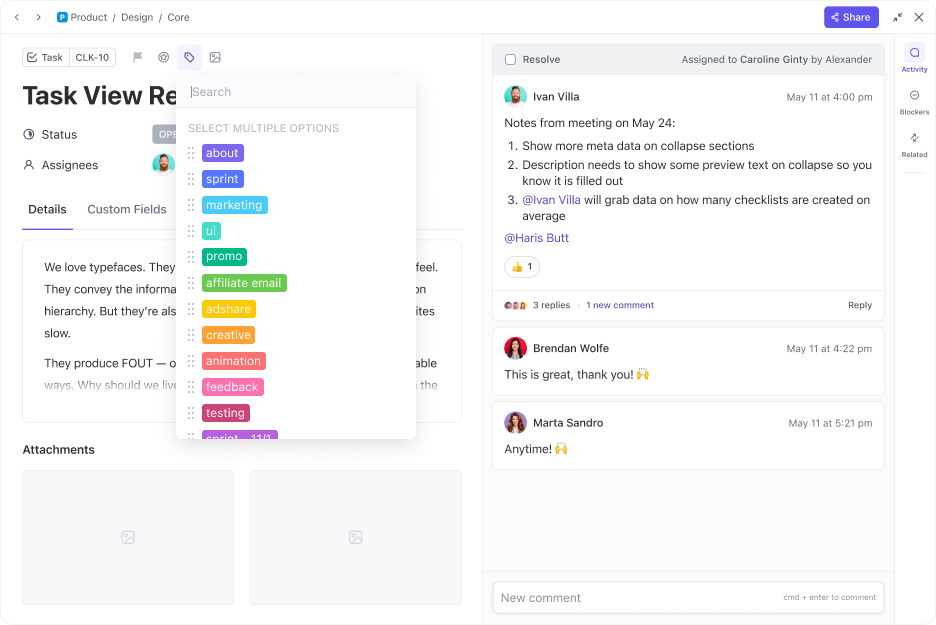
استخدم العلامات داخل مهمة في ClickUp لسهولة فرز وتصفية المرشحين لديك
راجع السير الذاتية بناءً على الوصف الوظيفي الخاص بك. نظرًا لأن هذه هي مرحلة التقييم الأولى من عملية التوظيف، ركز فقط على مواءمة المهارات المهنية والخلفية التعليمية والخبرة للمرشحين مع مواصفات الوظيفة. على سبيل المثال، إذا كنت تبحث عن شخص لديه 10 سنوات من الخبرة، فإن مطورًا جديدًا لديه خبرة قليلة أو معدومة لن يكون مقبولاً.
في هذه المرحلة، تريد في هذه المرحلة أن تضع قائمة طويلة بالمتقدمين الذين يستوفون المعايير الأساسية ويجب النظر إليهم. يمكنك أيضًا قراءة رسائلهم التعريفية بإيجاز لتكوين فكرة عامة عن مهاراتهم في التواصل، ووضوح أفكارهم وتماسكهم في التواصل الكتابي.
💡 نصيحة احترافية: استخدم الحقول المخصصة لإنشاء حقول مثل "الموقع"، و"الشركة الحالية"، و"الخبرة ذات الصلة"، وأي معلومات أخرى تريد تسجيلها؛ أضف العلامات مثل "إحالة الموظف" و"مؤهل" وأي علامات أخرى ترغب في استخدامها لتصفية الطلبات._
الخطوة 7: تنفيذ عملية فرز صارمة
مع تضييق مجموعة المرشحين، يمكنك التعمق أكثر في الملفات الشخصية للمرشحين المختارين.
حتى الآن، ربما تكون قد قمت حتى الآن بتقييم الملفات الشخصية من الناحية الكمية، ومقارنة الخبرة في عدد السنوات أو مطابقة المؤهلات التعليمية، وما إلى ذلك. أما الآن، فأنت بحاجة إلى إجراء فحص نوعي لكل مرشح وتجاوز ما هو موجود في سيرهم الذاتية. ينصب التركيز الآن على مواءمة المهارات المهنية للمرشح مع الاحتياجات المحددة لدور مهندس البرمجيات.
على سبيل المثال، إذا كنت تقوم ببناء فريق رشيق ، سيكون الشخص المطلع على خط أنابيب التكامل المستمر/النشر المستمر (CI/CD) والنشر الآلي أفضل من شخص يفتقر إلى هذه المعرفة.
لذا، حدد موعدًا أوليًا لمكالمة هاتفية أو اجتماع عبر الإنترنت لفهم تطلعات المرشح وخبرته ودوافعه. ناقش المشروع لتصور كيف يناسب المرشح متطلبات المشروع - ومؤسستك. والهدف من ذلك هو الحصول على فكرة عن خبراته العملية وقدراته على حل المشكلات وخبرته في تطوير البرمجيات لاستنتاج كيفية إضافته قيمة للمشروع التجاري.
تساعد مثل هذه الأسئلة المستهدفة في تنقية مجموعة المرشحين للمراحل اللاحقة، مما يضمن أن يكون المتقدمون مؤهلين على الورق والروح.
💡 نصيحة احترافية: هل تفقد جدولك الزمني أثناء إجراء مكالمات الفرز؟ مزامنة ClickUp مع تطبيق التقويم المفضل لديك لمشاركتها بنقرة واحدة مع المرشحين ومديري التوظيف وربطها بسير عمل التوظيف لديك

يتيح لك ClickUp Docs الكتابة والتعديل والتعليق والتعاون في الوقت الفعلي
الخطوة 9: إجراء مقابلات رسمية
بعد أن يستعرض المرشحون مهاراتهم في البرمجة، وقدراتهم على حل المشكلات، وكفاءتهم التقنية العامة في هندسة البرمجيات، حان الوقت لاختبار مهاراتهم الشخصية.
تعد المقابلات طريقة رائعة لقياس المهارات الشخصية للمرشح.
قم بتنظيم هذه المقابلات لتكون مركزة وشاملة. إليك ما يمكنك فعله لاكتساب المزيد من الرؤى من خلال كل تفاعل:
- ابدأ بـ مقدمة أساسية. دع المرشح يسلط الضوء على مهاراته الرئيسية وكفاءاته وخبراته السابقة وما إلى ذلك.
- استخدم التفاصيل التي تمت مشاركتها أعلاه كمحفز للانتقال إلى جوانب محددة من المرشح تهمك. على سبيل المثال، يمكنك انتقاء سمات شخصية أو مهارات محددة تحدث عنها المرشح واطلب منه أن يجسدها
- شجّعهم على مشاركة أمثلة من العالم الحقيقي تُظهر مهاراتهم أو سماتهم الشخصية المحددة
- ناقش المشاريع السابقة لفهم الدور الفردي للمرشح ومساهماته في نجاحها
- اطرح أسئلة سلوكية لفهم أساليب تعاونهم وقدرتهم على العمل ضمن فريق وقدرتهم على التكيف وسلوكهم العام
- مشاركة سيناريوهات افتراضية لقياس مهاراتهم في اتخاذ القرار أو حل النزاعات
- تقييم مدى فهمهم ل التقنيات والاتجاهات الناشئة في مجال تطوير البرمجيات
- الاستفسار عن تطلعاتهم المهنية وكيف يرون أنها تتماشى مع فرصة العمل الحالية (أو العكس)
بالإضافة إلى الإجابات الاعتيادية، ستعطيك إجابات المرشحين فكرة عن مهاراتهم الشخصية الخاصة بأساليب تواصلهم - قدرتهم على التعبير والتعبير.
يمكنك جدولة جولات متعددة من المقابلات مع فرق مختلفة لتقييم مهارات المرشح بشكل شامل. وفّر الوقت باستخدام قوالب المقابلات لتوجيه عملية التوظيف.
قم بزيادة كفاءة التوظيف إلى أقصى حد من خلال طرح الأسئلة الصحيحة بالترتيب الصحيح باستخدام قالب عملية المقابلة من ClickUp لفحص المرشحين بسهولة والعثور على المرشح المثالي
قالب عملية المقابلة في ClickUp يساعدك على إنشاء عملية مقابلة منظمة. استخدم قالب المستندات هذا لتقييم المرشحين بسرعة وإنصاف، وتزويد جميع المرشحين بتجربة مقابلة موحدة، والتعاون مع أصحاب المصلحة خلال العملية.
الخطوة 10: تقييم الملاءمة الثقافية
سواء كنت توظف مهندسي برمجيات على المدى الطويل أو مطوري برمجيات مستقلين على أساس مشروع، فإنك سترغب في الاحتفاظ بالمواهب حتى تصل إلى هذه الأهداف. لهذا السبب، يجب عليك تقييم ما إذا كانوا مناسبين ثقافياً لئلا يؤدي التوظيف إلى التخبط.
في هذه المرحلة، تقوم بتقييم ما إذا كانت قيم المؤسسة وديناميكيات الفريق وبيئة العمل تتطابق مع معتقدات الفرد وتوقعاته وروحه الشخصية أو المهنية. من الناحية المثالية، ستقوم بطرح أسئلة حول تفضيلات العمل أو أساليب التعاون لدى المرشح أثناء المقابلة لتكوين فكرة عامة عما إذا كان المرشح مناسباً من الناحية الثقافية.
ومع ذلك، بالنسبة للأدوار المهمة، قد ترغب في قضاء المزيد من الوقت في هذا الأمر. يقوم بعض مدراء التوظيف بإحضار المرشح إلى مكان العمل لمقابلة المرشحين أو جعلهم يتفاعلون مع الفريق في بيئة غير رسمية. يتيح ذلك للمرشح والفريق معرفة مدى توافقهم معًا. يمكنك تحديد موعد للقاء عبر الإنترنت أو حتى دعوتهم إلى فعاليات الشركة حتى تتمكن أنت والمرشح المحتمل من اكتساب نظرة ثاقبة على الجانب الثقافي للعمل معًا.
الخطوة 11: تحقق من المراجع
في هذه المرحلة من عملية التوظيف، تكون قائمة مطوري البرمجيات المحتملين قد تقلصت إلى عدد قليل فقط. ومع ذلك، قبل أن تقوم بالاختيار، والتفاوض على الشروط، وتقديم العرض، فإن إجراء فحص سريع لمراجعهم هو ممارسة جيدة. ستوفر هذه الخطوة نظرة ثاقبة على أدائهم السابق وخلفيتهم التقنية وأخلاقيات العمل وروح العمل الجماعي وغير ذلك.
وبما أن لديك بالفعل الملف الشخصي للمرشح وتاريخ خبرته العملية، يمكنك التواصل مع مؤسسته السابقة للحصول على نظرة نوعية عن أدائه:
- الكفاءة الفنية
- الموثوقية
- القدرة على العمل ضمن فريق
- إدارة الوقت
- القدرة على التكيف
- الاستجابة للملاحظات
ستخضع هذه الخطوة للقوانين المتعلقة بالتحقق من الجهات المرجعية في بلدك وولايتك. على سبيل المثال، بعض المؤسسات في الولايات المتحدة لديها متطلبات قانونية لإجراء تحريات عن خلفيات الموظفين قبل تعيين الموظفين، والتي تحتاج أيضاً إلى موافقة المرشح.
الخطوة 12: تقديم عرض تنافسي
مرحبًا بك في نهاية عملية التوظيف - أنت على وشك الوصول إلى خط النهاية.
لقد انتهيت من جميع عمليات البحث عن المواهب واستكشافها وفحصها. لقد حان الوقت الآن لتوظيف مهندسي البرمجيات من خلال تقديم شروط مقبولة بشكل متبادل. تعامل مع المفاوضات بشفافية وتركيز على المنافع المتبادلة.
ابدأ بفهم أولويات مهندس البرمجيات. هل يقدرون ساعات العمل المرنة أو العمل عن بُعد؟ هل يعطون الأولوية للنمو المهني على التقييمات المالية؟ احصل على فكرة عن محفزاتهم الأساسية وانظر كيف يمكنك تلبيتها على أفضل وجه
قم بتوصيل توقعات الشركة والموارد والفرص المتاحة. قم بتلبية احتياجات الطرفين حتى تتمكن من بدء هذه العلاقة بشكل إيجابي.
غالبًا ما يتلقى أفضل مطوري البرمجيات عروض عمل متعددة ويكونون في حيرة من أمرهم. ولضمان قدرتك على جذب أفضل المواهب، حافظ على مزاياك تنافسية بشكل معقول.
إذا كان كل شيء في محله، أصدر عرضاً مكتوباً واحصل على توقيع العقد!
الخطوة 13: قم بتوفير عملية تأهيل منظمة
بالطبع، لا تنتهي عملية التوظيف بانضمامهم إلى فريقك. يمكن أن تمهد تجربة التأهيل الإيجابية الطريق لعلاقة عمل ممتعة.
ابدأ بـ جلسة توجيهية حتى يعرف مهندس البرمجيات سياسات الشركة وإجراءاتها. وفي الوقت نفسه، شارك العديد من الموارد المفيدة للتأهيل لتسهيل عملية الانتقال السلس.
من الناحية المثالية، يجب أن تحتوي مجموعة أدوات التأهيل لمهندسي البرمجيات على ما يلي:
- دليل الموظف
- مخطط تنظيمي
- تفاصيل حزمة التكنولوجيا
- نظرة عامة على المشروعأهداف مهندس البرمجيات _توفر لك الوقت خلال عملية التوظيف بأكملها. أرسل رسائل البريد الإلكتروني، وأضف العلامات، وطبّق القوالب، وعيّن المهام باستخدام منطق "متى" و"ثم" للحفاظ على سير عملك تلقائياً
الخطوة 14: اجمع الملاحظات حول عملية التوظيف

استخدام نماذج الملاحظات لتحسين عملية التوظيف
يساعد تسجيل الملاحظات حول عملية التوظيف على التحسين المستمر وتحسين دورة مساعي التوظيف المستقبلية.
قم بتنفيذ آلية تغذية راجعة منظمة تجمع الرؤى من جميع أصحاب المصلحة الداخليين والخارجيين المعنيين - المرشحين، ومطور البرامج المختار، ومديري التوظيف، والقائمين على إجراء المقابلات، والجميع.
شجعهم على مناقشة نقاط القوة والضعف في مسار التوظيف، واطلب منهم أيضًا الحصول على مدخلات حول كيفية تبسيط أو تحسين بعض المجالات.
وبمجرد حصولك على جميع الملاحظات، يمكنك تحديد المشكلات المتكررة والتركيز عليها أولاً. بهذه الطريقة، ستعمل على تحسين عملية التوظيف ببطء وجذب المزيد من المواهب إلى مؤسستك
## قوالب توظيف مهندسي البرمجيات
يجب أن توضح استراتيجيتنا المكونة من 14 خطوة كيفية التعامل مع مهمة معقدة مثل توظيف مهندسي البرمجيات المناسبين. نحن الآن على وشك مشاركة سر لتعزيز عملية التوظيف لديك وجعلها أكثر كفاءة. نحن نتحدث عن قوالب التوظيف .
مع نماذج التوظيف، لن تضطر إلى إعادة اختراع العجلة. فهي توفر إطار عمل لكيفية القيام بعملية التوظيف، مع وجود مساحة كافية للتعديل حسب متطلباتك. فيما يلي بعض هذه القوالب الجاهزة للاستخدام والقابلة للتهيئة التي يمكن أن تساعدك:
توظيف المرشحين
نموذج توظيف المرشحين بواسطة ClickUp
توظيف المرشحين في ClickUp يسهِّل عملية التوظيف من خلال أدواته الشاملة المُعدَّة مسبقًا. وسواء كنت تتتبع الطلبات أو تنظمها حسب الدور الوظيفي والمهارات، فإن القالب يحتوي على كل ما تحتاجه لتسهيل العملية. إذا كنت تبحث عن تقييم عادل ومتناسق وتوظيف فعال لأفضل مهندسي البرمجيات، فهذا القالب مناسب لك!
مصفوفة اختيار التوظيف
قالب مصفوفة اختيار التوظيف بواسطة ClickUp
مصفوفة اختيار التوظيف في ClickUp تزيل كل العناء في فرز السير الذاتية وتقييمها. هنا، ما عليك سوى إدخال بيانات المرشح إلى جانب المعايير الأساسية والمرغوبة لاختيار المرشح، وستقوم مصفوفة الاختيار بكل العمل نيابةً عنك! بالإضافة إلى جعل القرار مستندًا إلى البيانات وأكثر دقة، فإن مصفوفة الاختيار هذه تقلل أيضًا من الوقت المطلوب.
### التوظيف والتعيين
نموذج التوظيف والتعيين بواسطة ClickUp
ال نموذج التوظيف والتوظيف على ClickUp عبارة عن مجموعة أدوات لتخزين البيانات وتنظيمها بشكل هرمي ومنطقي. يمكنك تحميل الموارد لأصحاب المصلحة الداخليين، وتتبع المرشحين، وعرض بطاقات التقييم، وجدولة المقابلات والمزيد. إنه حل مثالي للشركات الصغيرة لتحديد مهندس برمجيات بسرعة وفعالية لتلبية احتياجاتها الخاصة.
قائمة مراجعة التوظيف
قائمة مراجعة التوظيف من ClickUp
ال قائمة التحقق من التوظيف ClickUp تضمن سير كل شيء بسلاسة خلال عملية التوظيف. وهي قائمة تفاعلية توضح بالتفصيل جميع أنشطة التوظيف. كما تحتوي أيضًا على قسم يمكنك تخصيصه ومشاركته مع مهندس البرمجيات المعين حديثًا لتسهيل عملية التعيين.
## كيفية إعداد مطوري البرامج الجدد للنجاح
بمجرد انتهاء التدريب والتأهيل، سترغب في أن يبذل مهندس البرمجيات الخاص بك الوقت والجهد لتقديم حلول مبتكرة. ولكن، خلافاً للرأي الشائع، فإن مهندس البرمجيات لا يكون جيداً إلا بقدر جودة الأدوات التي يستخدمها. يجب عليك أيضًا تزويد مهندس البرمجيات بالأدوات والتقنيات المناسبة لمساعدته على تحقيق أهدافه.
ClickUp هي الأداة التي تحتاجها.
تمكن ClickUp من إثبات جدارته في مشاريع هندسة البرمجيات من خلال ميزاته وقدراته التالية:
- قابلة للتخصيص: صمم مساحتك على طريقتك. منطرق عرض مختلفة للمشروع إلىالحقول المخصصة، يمكن لمهندس البرمجيات تعديل المنصة لتتناسب مع سير عمل وعمليات التطوير الخاصة بهم

يمكن لمهندسي البرمجيات إنشاء لوحات معلومات ClickUp Dashboards مفصلة وإضافة بطاقات بسهولة لعرض التقدم المحرز في نقاط السباق والمهام لكل حالة والأخطاء لكل عرض
- مدعومة بالذكاء الاصطناعي:ClickUp Brain هو مساعد ذكاء اصطناعي من الجيل التالي لمستخدمي ClickUp. يمكنك استخدامه لإنشاء منشورات توظيف جذابة، وتوصيفات مفصلة للوظائف، وتلخيص السير الذاتية للمرشحين. كما يمكن لمطوِّر البرامج الخاص بك استخدامه لكتابة أو تصحيح الرموز أو إدارة قواعد المعرفة - فالإمكانيات لا حدود لها
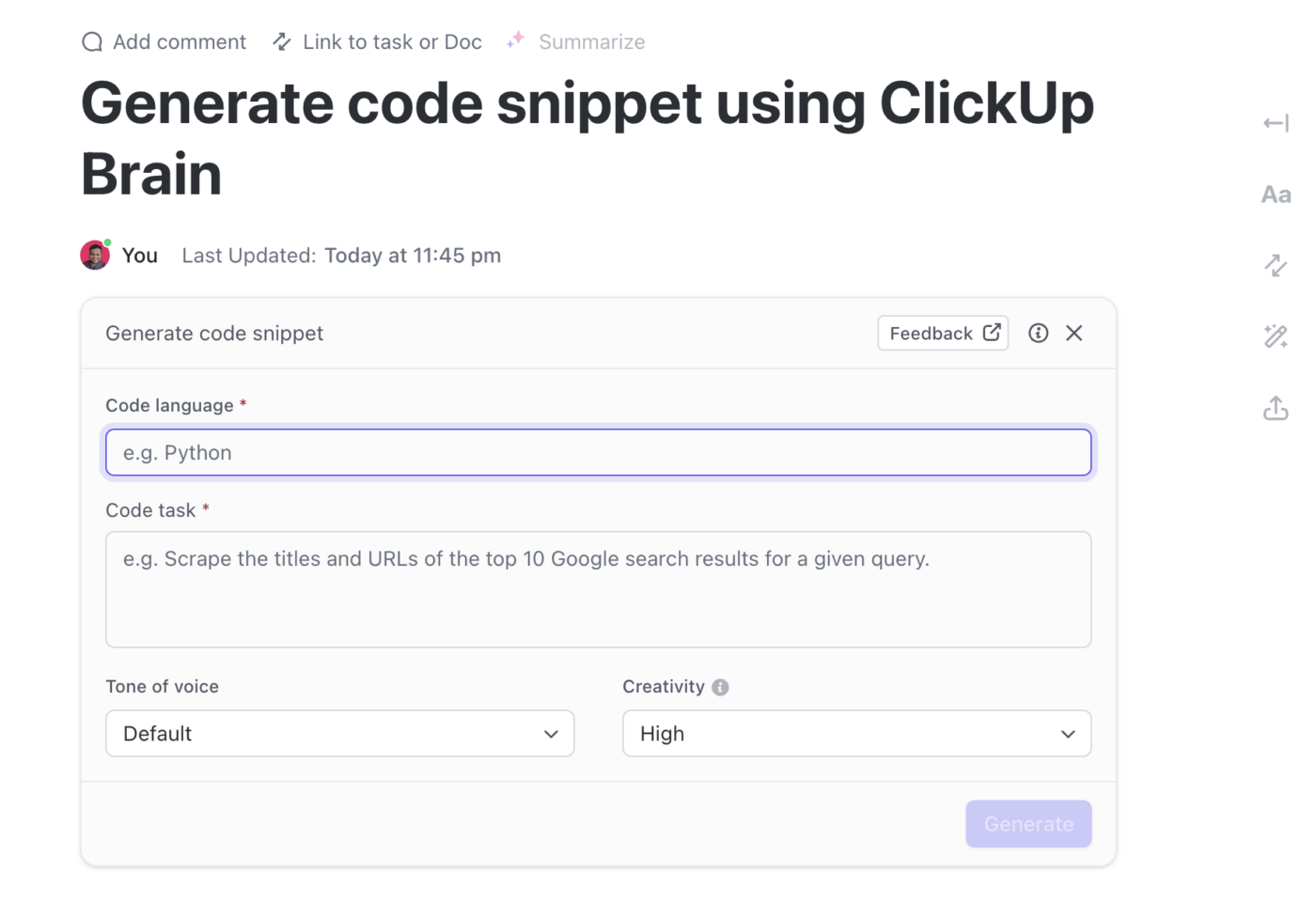
قم بتبسيط البرمجة باستخدام منشئ مقتطفات التعليمات البرمجية للذكاء الاصطناعي من ClickUp
- أتمتة: أتمتة النقر يسمح لمهندس البرمجيات بالاختيار من مكتبة تضم أكثر من 100 عملية أتمتة معدة مسبقًا أو إنشائها من الصفر وفقًا لاحتياجات مشاريع التطوير

أتمتة العمليات وسير العمل على ClickUp
- التوثيق:مستندات ClickUp هو مستودع مركزي لجميع المستندات ومواقع الويكي وغيرها. ادعم التعليمات البرمجية الخاصة بك بوثائق قوية باستخدام ClickUp Docs
- التعاون: تبادل الأفكار على السبورات البيضاء أو الدردشة أو مشاركة الموارد في التعليقات. ClickUp يدعم العمل التعاوني بأكثر من طريقة
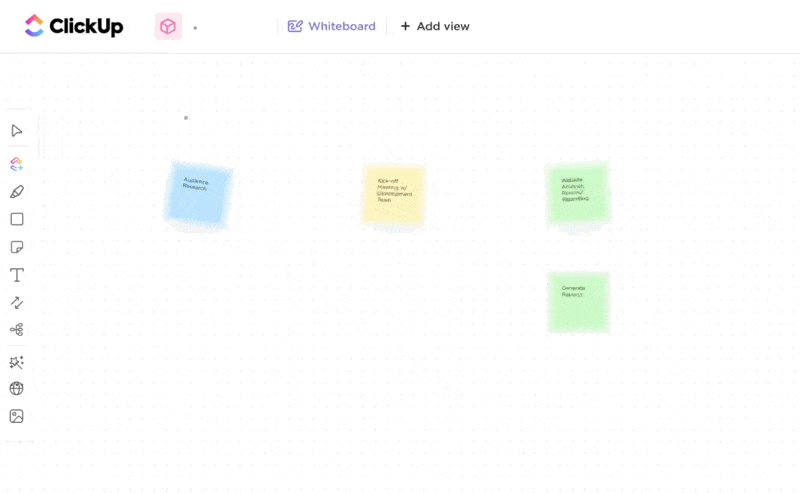
استخدم اللوحات البيضاء على ClickUp للتنسيق مع فريقك
- المنهجيات الرشيقة: مع ميزات مثل لوحات المعلومات الرشيقة المخصصة، وتتبع المراحل، وسباقات السرعة، وما إلى ذلك، يجعل ClickUp التطوير الرشيق رشيقًا حقًا
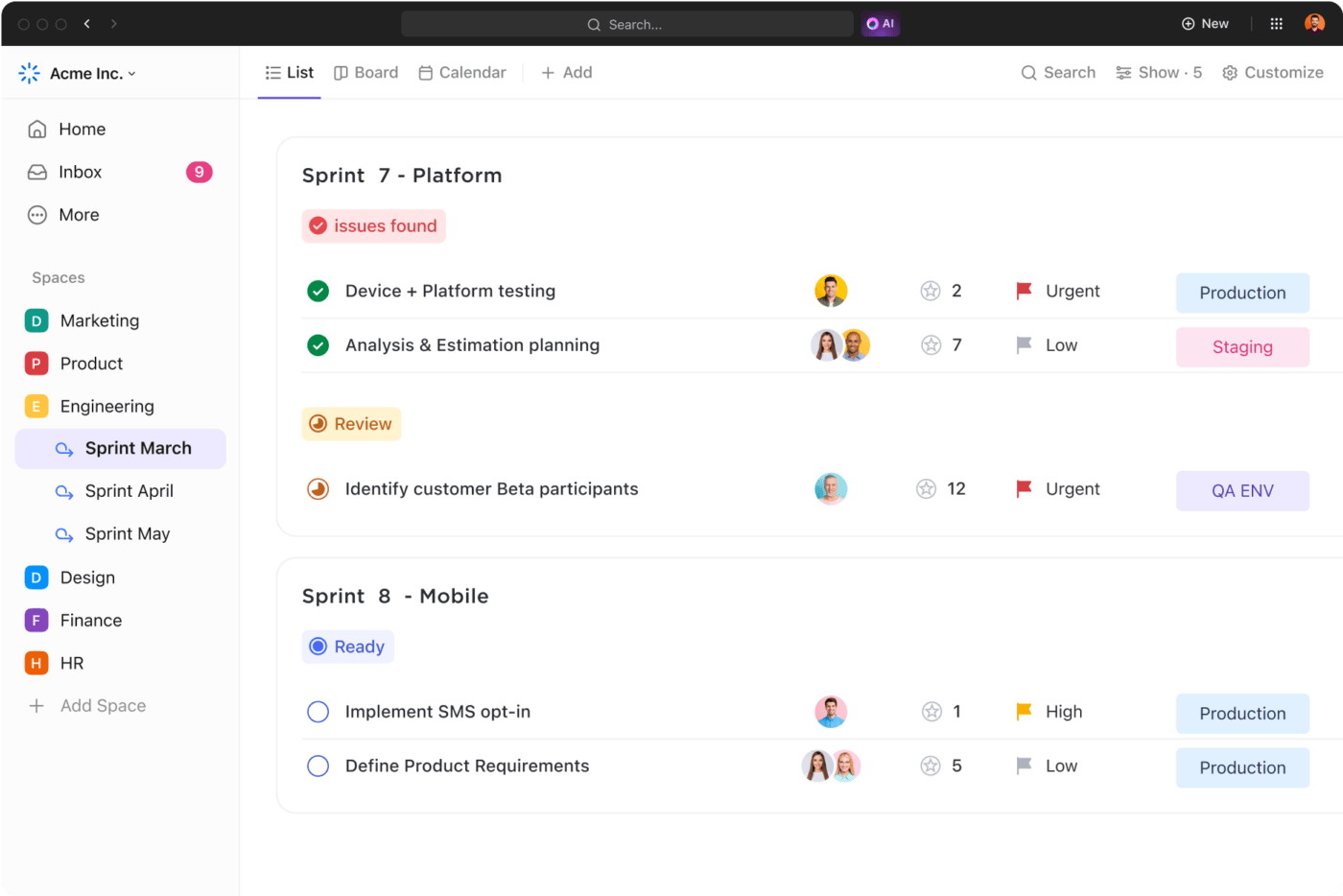
احصل على رؤى سريعة حول سباقات السرعة لفرقك باستخدام طريقة عرض قائمة سبرينت ClickUp Sprint List
- عمليات التكامل: يدعم ClickUp العديد من عمليات التكامل، مثل GitHub أو Bitbucket للتحكم في الإصدار، و Jira أو Redmine لتتبع الأخطاء، و Figma للنماذج الأولية لتطبيقات الويب، وغيرها. إن القدرة على دمج منصات وتطبيقات وأنظمة مختلفة مع ClickUp تجعلها أداة لا تقدر بثمن لمهندسي البرمجيات.
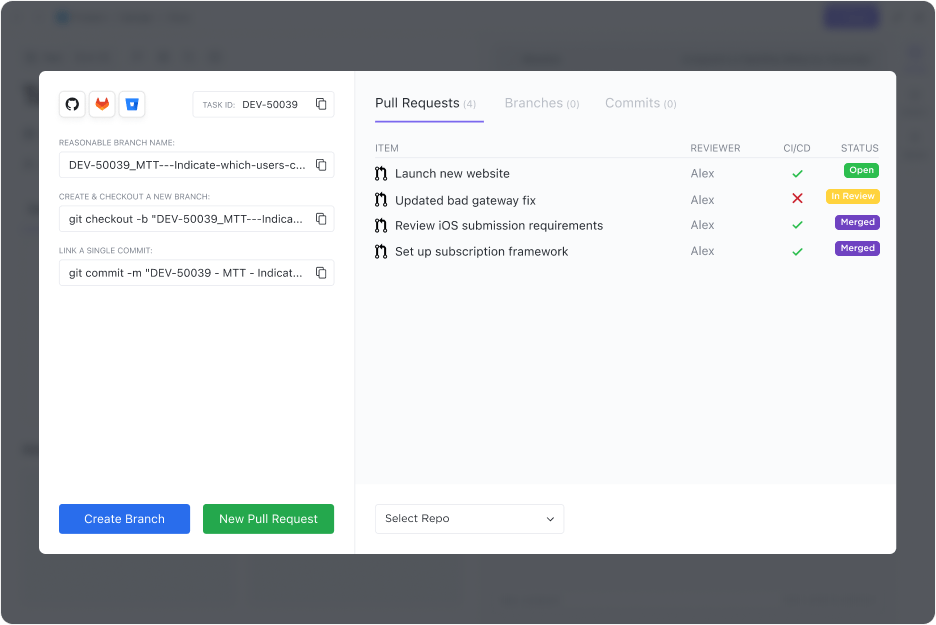
ClickUp يتكامل مع أمثال GitHub لتسهيل تطوير البرمجيات
اقرأ أيضًا:
/ href/ /blog?p=57958 القوالب الأكثر فائدة لمهندسي البرمجيات //%href/
خلاصة: توظيف مطوري البرمجيات
- تحديد المتطلبات وفجوات المهارات
- إنشاء وصف وظيفي مفصل
- تحقق من احتياطيات المواهب الموجودة
- نشر خطة التوظيف الخاصة بك على الإنترنت وفي المجتمعات التقنية
- وضع قائمة مختصرة بالمرشحين المؤهلين وفرزهم
- استخدم التقييم الفني لتأهيل المرشحين للمقابلات
- إجراء المقابلات وتقييم الملاءمة الثقافية
- التحقق من المراجع وطرح عرض تنافسي
- امنحهم تدريبًا لطيفًا ومنظمًا على متن الطائرة
- استخدم الأدوات والقوالب لتوفير الوقت قدر الإمكان
أصبح التوظيف في مجال التكنولوجيا أسهل مع ClickUp
نأمل أن تكون هذه النصائح حول كيفية توظيف مهندس برمجيات مفيدة. في حين أن ClickUp هو أداة قوية أداة إنتاجية للمطورين فهي أيضًا أداة لا تقدر بثمن بالنسبة لمسؤولي التوظيف ومديري التوظيف. يمكنك استخدامه بفعالية كبيرة كـ أداة توظيف كذلك
استخدم ClickUp Brain لصياغة توصيفات مقنعة للوظائف، ونماذج لالتقاط معلومات المرشحين، ووثائق لتخزين جميع البيانات الداخلية والخارجية، وتقويم لصياغة جدول زمني للمقابلات، ونماذج لبدء العملية - والقائمة تطول.
وعلاوة على ذلك، يمكنك عرض جميع الأنشطة في مساحة مركزية والحصول على تحديثات في الوقت الفعلي لعملية التوظيف.
لذلك، سواء كنت تستخدمه لتوظيف مهندس أو لدعمه في وظيفته، فإن ClickUp هو كل ما تحتاجه! تسجيل الدخول لتجربته!


